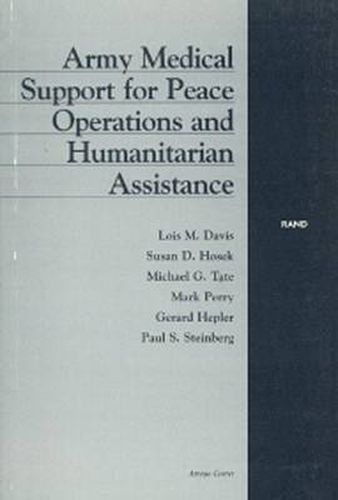Readings Newsletter
Become a Readings Member to make your shopping experience even easier.
Sign in or sign up for free!
You’re not far away from qualifying for FREE standard shipping within Australia
You’ve qualified for FREE standard shipping within Australia
The cart is loading…






The U.S. military is increasingly being called upon to provide medical support for U.S. forces, coalition forces, and civilian populations in operations other than war (OOTW)–a broad range of missions including peace operations, humanitarian assistance, disaster relief, and nation assistance, among others. This report focuses on lessons from recent operations in Somalia and the Balkans. It finds that such operations impose a broader range of demands for medical services than do traditional combat scenarios, and they raise numerous difficult issues, e.g., holes that appear in the theater medical system, wide variations in medical assets and practices among coalition members, great variability in medical readiness among coalition forces, and both external and internal pressures to expand the U.S. medical mission. In addition, in these operations the medical mission often tends to be broader than just supporting the deploying force. Since such missions are increasingly frequent, the authors recommend that the Army enhance the flexibility and tailorablity of its medical elements in order to accommodate the diversity of new missions it faces in OOTW and coalition environments, educate medical planners and Army Medical Department personnel about the variability and features of operations other than war, and become more proactively involved in the strategic planning process.
$9.00 standard shipping within Australia
FREE standard shipping within Australia for orders over $100.00
Express & International shipping calculated at checkout
The U.S. military is increasingly being called upon to provide medical support for U.S. forces, coalition forces, and civilian populations in operations other than war (OOTW)–a broad range of missions including peace operations, humanitarian assistance, disaster relief, and nation assistance, among others. This report focuses on lessons from recent operations in Somalia and the Balkans. It finds that such operations impose a broader range of demands for medical services than do traditional combat scenarios, and they raise numerous difficult issues, e.g., holes that appear in the theater medical system, wide variations in medical assets and practices among coalition members, great variability in medical readiness among coalition forces, and both external and internal pressures to expand the U.S. medical mission. In addition, in these operations the medical mission often tends to be broader than just supporting the deploying force. Since such missions are increasingly frequent, the authors recommend that the Army enhance the flexibility and tailorablity of its medical elements in order to accommodate the diversity of new missions it faces in OOTW and coalition environments, educate medical planners and Army Medical Department personnel about the variability and features of operations other than war, and become more proactively involved in the strategic planning process.